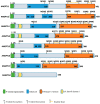Angiopoietin-Like Proteins in Angiogenesis, Inflammation and Cancer
- PMID: 29389861
- PMCID: PMC5855653
- DOI: 10.3390/ijms19020431
Angiopoietin-Like Proteins in Angiogenesis, Inflammation and Cancer
Abstract
Altered expression of secreted factors by tumor cells or cells of the tumor microenvironment is a key event in cancer development and progression. In the last decade, emerging evidences supported the autocrine and paracrine activity of the members of the Angiopoietin-like (ANGPTL) protein family in angiogenesis, inflammation and in the regulation of different steps of carcinogenesis and metastasis development. Thus, ANGPTL proteins become attractive either as prognostic or predictive biomarkers, or as novel target for cancer treatment. Here, we outline the current knowledge about the functions of the ANGPTL proteins in angiogenesis, cancer progression and metastasis. Moreover, we discuss the most recent evidences sustaining their role as prognostic or predictive biomarkers for cancer therapy. Although the role of ANGPTL proteins in cancer has not been fully elucidated, increasing evidence suggest their key effects in the proliferative and invasive properties of cancer cells. Moreover, given the common overexpression of ANGPTL proteins in several aggressive solid tumors, and their role in tumor cells and cells of the tumor microenvironment, the field of research about ANGPTL proteins network may highlight new potential targets for the development of future therapeutic strategies.
Keywords: angiogenesis; angiopoietin-like proteins; cancer; inflammation.
Conflict of interest statement
The authors declare no conflict of interest.
Figures
References
-
- Oike Y., Yasunaga K., Ito Y., Matsumoto S., Maekawa H., Morisada T., Arai F., Nakagata N., Takeya M., Masuho Y., et al. Angiopoietin-related growth factor (AGF) promotes epidermal proliferation, remodeling, and regeneration. Proc. Natl. Acad. Sci. USA. 2003;100:9494–9499. doi: 10.1073/pnas.1531901100. - DOI - PMC - PubMed
-
- Ito Y., Oike Y., Yasunaga K., Hamada K., Miyata K., Matsumoto S., Sugano S., Tanihara H., Masuho Y., Suda T. Inhibition of angiogenesis and vascular leakiness by angiopoietin-related protein 4. Cancer Res. 2003;63:6651–6657. - PubMed
Publication types
MeSH terms
Substances
LinkOut - more resources
Full Text Sources
Other Literature Sources


